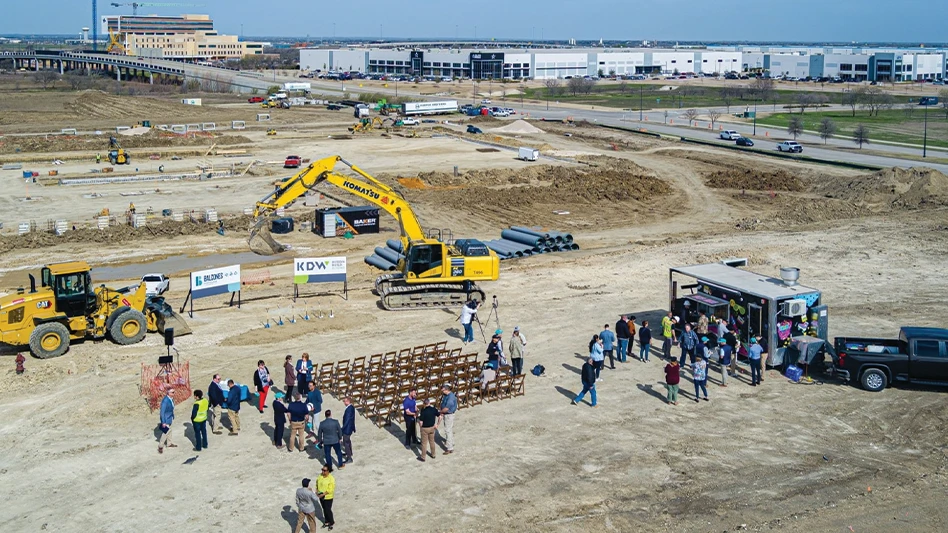METAL ROOFING MAKES INROADS
Whether your tastes run toward Jack-in-the-Box or Outback Steakhouse, the odds are getting better that you’ll be dining under a metal roof.
Architects and builders are increasingly using metal roofing in commercial and institutional buildings, and some inroads are even being made on the residential front, according to representatives from Berridge Manufacturing Co., San Antonio, Texas.
Speaking at a recent continuing education seminar held in Cleveland and sponsored by the American Institute of Architects, corporate architect Ian Gordon and regional sales representative Jim Bieszki noted that metal roofing’s market share has climbed considerably in the past 10 years.
Galvanized steel and aluminum roofs have always had a presence in the warehouse and industrial building sector, but low maintenance and long wear life advantages are combining with an increasingly broad color selection to give the material greater appeal in applications for restaurants, shopping centers, schools and churches.
Berridge Manufacturing uses galvanized steel coils (and to a lesser extent, galvanized aluminum) to make roofing panels and shapes. The company offers more than 30 colors and several textures and designs custom colors for multiple-location customers such as Burger King and Loews.
According to Gordon, just 10 years ago metal roofing’s overall market share across all building segments was 10 percent. But a survey conducted last year showed that architects are now specifying metal roofing for some 40 percent of the buildings they design in the commercial and industrial sectors.
While metal roofing can cost a little more upfront compared to asphalt shingles and some other types of roofing, building owners and contractors see a payoff in the form of lower maintenance costs (no flashing; no sumps to move standing water as with flat roofs) and longer life.
Berridge also sells cutting systems used by contractors such as Tom Geist of The Geist Co., Cleveland.
Geist says the procedure typically generates very little work-site scrap, as it is designed to use coils in the exact width needed.
Sponsored Content
Labor that Works
With 25 years of experience, Leadpoint delivers cost-effective workforce solutions tailored to your needs. We handle the recruiting, hiring, training, and onboarding to deliver stable, productive, and safety-focused teams. Our commitment to safety and quality ensures peace of mind with a reliable workforce that helps you achieve your goals.
Sponsored Content
Labor that Works
With 25 years of experience, Leadpoint delivers cost-effective workforce solutions tailored to your needs. We handle the recruiting, hiring, training, and onboarding to deliver stable, productive, and safety-focused teams. Our commitment to safety and quality ensures peace of mind with a reliable workforce that helps you achieve your goals.
Sponsored Content
Labor that Works
With 25 years of experience, Leadpoint delivers cost-effective workforce solutions tailored to your needs. We handle the recruiting, hiring, training, and onboarding to deliver stable, productive, and safety-focused teams. Our commitment to safety and quality ensures peace of mind with a reliable workforce that helps you achieve your goals.
Sponsored Content
Labor that Works
With 25 years of experience, Leadpoint delivers cost-effective workforce solutions tailored to your needs. We handle the recruiting, hiring, training, and onboarding to deliver stable, productive, and safety-focused teams. Our commitment to safety and quality ensures peace of mind with a reliable workforce that helps you achieve your goals.
Sponsored Content
Labor that Works
With 25 years of experience, Leadpoint delivers cost-effective workforce solutions tailored to your needs. We handle the recruiting, hiring, training, and onboarding to deliver stable, productive, and safety-focused teams. Our commitment to safety and quality ensures peace of mind with a reliable workforce that helps you achieve your goals.
Sponsored Content
Labor that Works
With 25 years of experience, Leadpoint delivers cost-effective workforce solutions tailored to your needs. We handle the recruiting, hiring, training, and onboarding to deliver stable, productive, and safety-focused teams. Our commitment to safety and quality ensures peace of mind with a reliable workforce that helps you achieve your goals.
Sponsored Content
Labor that Works
With 25 years of experience, Leadpoint delivers cost-effective workforce solutions tailored to your needs. We handle the recruiting, hiring, training, and onboarding to deliver stable, productive, and safety-focused teams. Our commitment to safety and quality ensures peace of mind with a reliable workforce that helps you achieve your goals.
He indicated that some customers are inquiring into recyclability, especially when working within a "green building" framework.
Get curated news on YOUR industry.
Enter your email to receive our newsletters.

Explore the September 2003 Issue
Check out more from this issue and find your next story to read.
Latest from Recycling Today
- Smithers report looks at PCR plastic’s near-term prospects
- Plastics association quantifies US-EU trade dispute impacts
- Nucor expects slimmer profits in early 2025
- CP Group announces new senior vice president
- APR publishes Design Guide in French
- AmSty recorded first sales of PolyRenew Styrene in 2024
- PRE says EU’s plastic recycling industry at a breaking point
- Call2Recycle Canada, Staples Professional expand partnership






